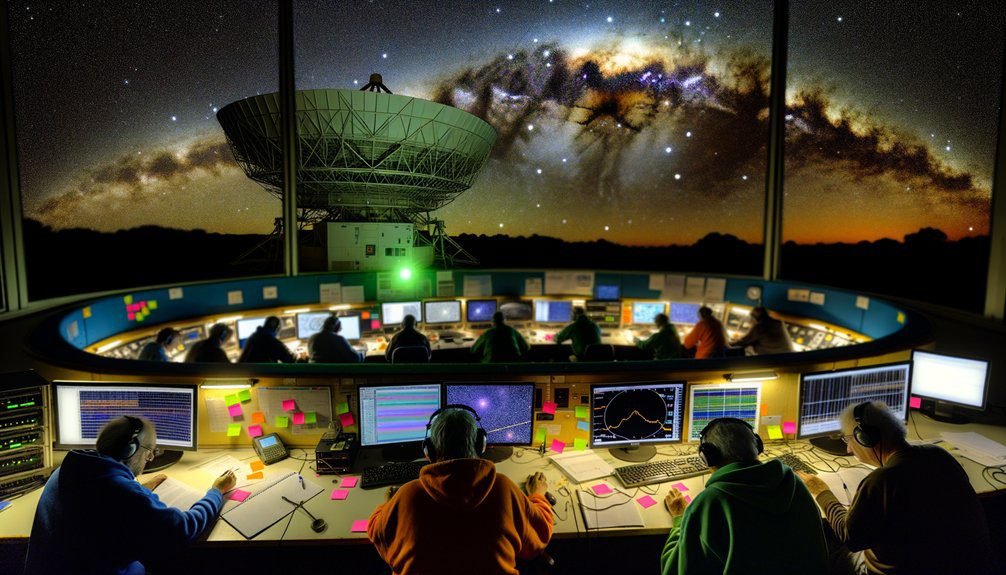You should consider three proven approaches: Breakthrough Listen’s wideband surveys that use very sensitive telescopes and huge data pipelines to maximize detection probability; the SETI Institute’s Allen Telescope Array for continuous, targeted monitoring with parallel beams and rapid follow-up; and coordinated METI plus citizen‑science programs that expand coverage, speed candidate vetting, and engage volunteers. Each combines sensitivity, persistence, and processing power to find technosignatures — keep going and you’ll uncover how they complement each other.
Key Takeaways
- Breakthrough Listen: widest-band, high-sensitivity surveys prioritizing nearby stars and the galactic center for comprehensive technosignature searches.
- Allen Telescope Array (SETI Institute): continuous, multi-target monitoring with parallel beams enabling long-duration observations and rapid follow-ups.
- Projects combining wideband receivers and real-time pipelines increase true-signal detection while filtering terrestrial interference efficiently.
- Citizen-science and METI collaborations expand observational reach and data processing, with governance addressing ethical and risk concerns.
- Robust computing and reproducible algorithms are essential for petabyte-class archives, candidate prioritization, and reliable signal verification.
Breakthrough Listen: Wideband Sky Surveys With Powerful Telescopes

Although Breakthrough Listen targets both nearby stars and the galactic center, its core strategy is systematic, wideband surveys using some of the world’s most sensitive radio and optical telescopes. You’ll see that the program emphasizes breadth: it captures large frequency ranges simultaneously, leveraging wideband technology to maximize discovery space and reduce observational bias. You’ll rely on data pipelines that quantify telescope sensitivity across bands, enabling objective prioritization of follow-up candidates. Instrumental calibrations, radio-frequency interference excision, and real-time candidate ranking are framed as measurable performance metrics rather than speculative features. You’ll appreciate the program’s dual approach: deep integrations on promising targets plus rapid, repeated sweeps to sample transient phenomena. Computational resources are provisioned to handle petabyte-class archives and to run reproducible signal-detection algorithms. For you, the takeaway is straightforward—Breakthrough Listen trades targeted narrowness for extensive spectral coverage, using high telescope sensitivity and wideband technology to systematically increase the probability of detecting technosignatures.
SETI Institute’s Allen Telescope Array: Targeted and Continuous Monitoring
Because the Allen Telescope Array was designed for simultaneous, continuous monitoring of many targets, you can run long-duration observations and rapid follow-ups without reconfiguring the instrument. You’ll benefit from an array architecture that trades dish size for multiplicity, enabling parallel beams and flexible pointing. The telescope technology emphasizes modularity and low-noise receivers, which reduce overhead and increase observing duty cycle. On the data side, real-time signal processing pipelines filter interference, search narrowband carriers, and flag transient candidates for immediate review. That combination lets you prioritize targets scientifically while maintaining survey continuity.
Operationally, you’ll use automated schedulers to allocate time across stellar lists, maintain continuous calibration, and route data to scalable compute clusters. The result is a focused, efficient platform: targeted observations with continuous coverage and the capacity to interrogate suspicious signals quickly. In practice, this reduces false positives and improves your chances of detecting persistent or repeating technosignatures.
METI and Citizen Science Initiatives: Active Searches and Public Participation

When you pivot from passive listening to deliberate messaging, METI (Messaging to Extraterrestrial Intelligence) programs and citizen science initiatives change the balance between outreach, risk management, and detection strategy. You’ll weigh intentional transmissions against ethical concerns, and you’ll engage volunteers to extend observational reach. METI frames policy questions; citizen science supplies manpower, pattern recognition, and distributed computing for signal searches. Public engagement and collaborative research shape priorities, transparency, and consent. You’ll adopt protocols for message content, target selection, and risk assessment while leveraging platforms that let nonprofessionals classify candidates and run software agents.
| Intent | Emotion | Role |
|---|---|---|
| METI transmission | Awe | Policy focus |
| Citizen analytics | Hope | Data processing |
| Volunteer discovery | Pride | Verification duty |
You’ll keep methods rigorous: versioned code, reproducible pipelines, and clear governance. This hybrid approach accelerates detection capability while demanding disciplined oversight and inclusive dialogue.
Frequently Asked Questions
Will SETI Detect Alien Probes Within Our Solar System?
Not likely — SETI’s ears are tuned to radio and optical whispers, not hunting metallic needles in a cosmic haystack. Think of alien technology as a dim lighthouse; unless it’s broadcasting, you’ll miss it. Solar exploration missions and targeted searches (optical surveys, radar, spacecraft inspections) stand a better chance of finding probes. You’d need coordinated in-situ exploration, high-resolution imaging, and anomaly detection to reliably discover any local artifacts.
How Do SETI Programs Handle False Positives From Satellites?
They flag likely satellite interference, then apply signal verification steps to rule out human sources. You’d see automated filters removing known satellite bands and Doppler patterns, multi-site coincident checks, and archival cross-checks against catalogues. Analysts run higher-resolution scans, direction-of-arrival estimates, and reobservations. If it survives those tests, you’d escalate to independent observatories and follow strict reporting protocols before declaring anything unexplained.
Can SETI Signals Be Encrypted or Intentionally Hidden?
Yes — signals could be encrypted or intentionally hidden. You’d expect advanced senders to use signal encryption, steganography, or spread-spectrum techniques to hide messages within noise or mimic natural sources. You’d need statistical, spectral and pattern-analysis tools plus cross-validation across observatories to detect anomalies. Decoding would require assumptions about encoding, shared mathematics, or trial decryption. Confirmation needs reproducible reception, cooperative analysis, and exclusion of terrestrial interference.
What Legal Rules Govern Sending Messages to Extraterrestrials?
You’re mostly guided by informal norms rather than hard laws: no binding international treaty specifically regulates extraterrestrial communication, though international treaties like the Outer Space Treaty set peaceful-use and responsibility principles. Scientific bodies (IAC, COSPAR, IAA) and SETI communities publish protocols recommending transparency, consultation, and risk assessment before you transmit. National export, radio-spectrum and space-activity laws may apply, so you’ll need legal and scientific coordination prior to any intentional transmission.
How Do Funding Cuts Affect Long-Term SETI Projects?
When NASA cut radio survey funding, you’d see projects pause and data gaps that undermine funding sustainability and project longevity. You’ll lose staff, stop long-baseline observations, and break continuity needed to detect rare signals. That raises restart costs and deters collaborators and donors, creating a vicious cycle. To mitigate this, you’d diversify funding, build international partnerships, and design modular, low-cost instruments to preserve long-term data integrity and expertise.